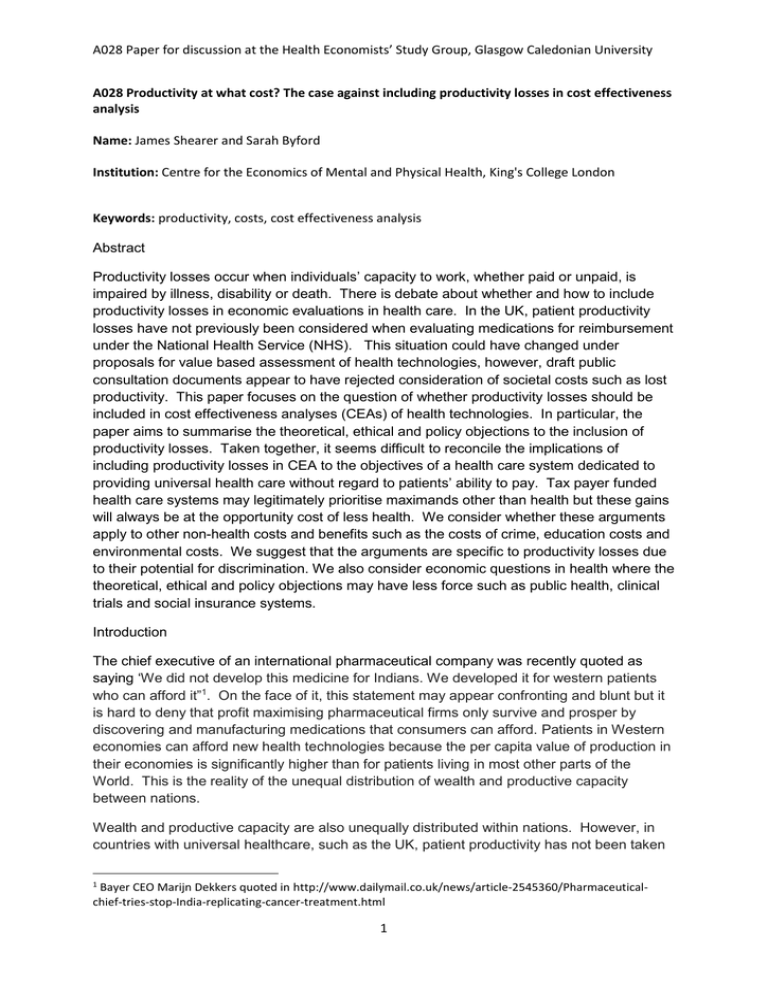A028 - Glasgow Caledonian University
advertisement

A028 Paper for discussion at the Health Economists’ Study Group, Glasgow Caledonian University A028 Productivity at what cost? The case against including productivity losses in cost effectiveness analysis Name: James Shearer and Sarah Byford Institution: Centre for the Economics of Mental and Physical Health, King's College London Keywords: productivity, costs, cost effectiveness analysis Abstract Productivity losses occur when individuals’ capacity to work, whether paid or unpaid, is impaired by illness, disability or death. There is debate about whether and how to include productivity losses in economic evaluations in health care. In the UK, patient productivity losses have not previously been considered when evaluating medications for reimbursement under the National Health Service (NHS). This situation could have changed under proposals for value based assessment of health technologies, however, draft public consultation documents appear to have rejected consideration of societal costs such as lost productivity. This paper focuses on the question of whether productivity losses should be included in cost effectiveness analyses (CEAs) of health technologies. In particular, the paper aims to summarise the theoretical, ethical and policy objections to the inclusion of productivity losses. Taken together, it seems difficult to reconcile the implications of including productivity losses in CEA to the objectives of a health care system dedicated to providing universal health care without regard to patients’ ability to pay. Tax payer funded health care systems may legitimately prioritise maximands other than health but these gains will always be at the opportunity cost of less health. We consider whether these arguments apply to other non-health costs and benefits such as the costs of crime, education costs and environmental costs. We suggest that the arguments are specific to productivity losses due to their potential for discrimination. We also consider economic questions in health where the theoretical, ethical and policy objections may have less force such as public health, clinical trials and social insurance systems. Introduction The chief executive of an international pharmaceutical company was recently quoted as saying ‘We did not develop this medicine for Indians. We developed it for western patients who can afford it”1. On the face of it, this statement may appear confronting and blunt but it is hard to deny that profit maximising pharmaceutical firms only survive and prosper by discovering and manufacturing medications that consumers can afford. Patients in Western economies can afford new health technologies because the per capita value of production in their economies is significantly higher than for patients living in most other parts of the World. This is the reality of the unequal distribution of wealth and productive capacity between nations. Wealth and productive capacity are also unequally distributed within nations. However, in countries with universal healthcare, such as the UK, patient productivity has not been taken 1 Bayer CEO Marijn Dekkers quoted in http://www.dailymail.co.uk/news/article-2545360/Pharmaceuticalchief-tries-stop-India-replicating-cancer-treatment.html 1 A028 Paper for discussion at the Health Economists’ Study Group, Glasgow Caledonian University into account when determining the value of a new health technology. Proposals for Value Based Pricing (VBP) of medicines in the UK included additional payments to interventions deemed to provide wider societal benefits beyond the health of a patient including productivity (Raftery 2013). However, a draft public consultation document released by the National Institute for Health and Care Excellence (NICE) on 22 January 20142 rejected the wider societal benefit approach due to difficulties the working party had with equity implications around including productivity losses and the underpinning theoretical economic arguments. The aim of this paper is summarise the theoretical, policy and methodological arguments against the inclusion of productivity losses in health economic evaluations that might have swayed the NICE working party. The focus will be on the case against inclusion due to the NICE working group’s decision and also because the literature comprises mainly methodological papers that are based on a presumption in favour of inclusion (i.e. (Zhang, Bansback et al. 2011, Krol, Brouwer et al. 2013, Lensberg, Drummond et al. 2013, Krol and Brouwer 2014)). This paper also aims to make decision makers and patient groups aware of the unintended and potentially undesirable consequences of acceding to calls to count productivity losses in health technology assessment. Should patients with relatively more productive capacity be favoured over those with less? In economic terms, are we prepared to sacrifice effective treatments for the elderly and disabled for less effective interventions that target younger or working patients based on productivity savings? What is the ultimate purpose of a national health system – to maximise health or wealth? What are productivity losses? Patient productivity was defined by the UK Department of Health as the sum of paid production (labour provided by patients in paid employment) plus unpaid production (unpaid work done by patients but valued by others)3. Unpaid patient production includes domestic work, child care, voluntary work and informal health care (Brouwer, Rutten et al. 2001). Paid patient productivity is a function of time spent working. Lost working time due to illness can take the form of absenteeism (long or short term), reduced working hours, early retirement and/or presenteesim (reduced on-the-job productivity) (Brouwer, Rutten et al. 2001). How much of the total value of patients’ productivity losses should be included in a CEA depends on the analytical perspective of the evaluation (Drummond, Sculpher et al. 2005). Third party payers, such as private health insurers and national health systems, usually will not consider any patient productivity losses since these costs do not fall on their budgets. This is the present guidance for new health technologies in the UK (NICE 2013). However, from the perspective of governments that fund national health systems, patient productivity losses may be relevant because of lost tax revenue from reduced wages and increased 2 National Institute for Health and Care Excellence, Value Based Assessment of Health Technologies (Item 4) draft proposals for public consultation http://www.nice.org.uk/media/B00/0E/January2014PublicBoardMeetingAgendaAndPapers.pdf 3 Methodology for estimating “Wider Societal Benefits” as the net production impact of treatments http://www.nice.org.uk/media/FE2/F0/DH_Documentation_for_Wider_Societal_Benefits.pdf 2 A028 Paper for discussion at the Health Economists’ Study Group, Glasgow Caledonian University welfare payments (Drummond, Sculpher et al. 2005). A societal perspective includes all the costs and consequences of health care decisions, regardless of who pays or who benefits, in order to provide a total assessment of efficiency (Sculpher 2001). It has been strongly argued on this basis that all patient productivity losses should be included in CEA wherever treatment may impact patients ability to work(Krol and Brouwer 2014) (Brouwer, Rutten et al. 2001, Sculpher 2001). How is lost productivity valued? There are two main methods used to value productivity losses (Zhang, Bansback et al. 2011, Lensberg, Drummond et al. 2013). The human capital approach (HCA) treats patients as assets that contribute production to the economy. The value to the economy of their lost production is calculated by applying gross wages plus benefits to the time taken off work due to illness. Gross wages are used as a proxy value of the marginal productivity labour theoretically capturing the total value of an individual’s output to the economy (Brouwer, Koopmanscahp et al. 1997, Herrero and Moreno-Ternero 2009). The human capital approach has been criticised for overestimating the costs of lost productivity because it fails to account for the possibility that sick or incapacitated workers can be replaced thereby limiting the societal economic loss (Browuer, Koopmanschap et al. 1997).(Drummond, Sculpher et al. 2005).The friction cost approach focuses on the replacement cost based on the time and expense of replacing an absent ill worker such as training and advertising (Koopmanschap, Rutten et al. 1995). Essentially productivity losses are limited due to the availability of other unemployed or underemployed workers. Friction cost based estimates of productivity losses are often only a very small fraction of estimates based on the human capital approach (Lensberg, Drummond et al. 2013). However, the friction cost approach has several important limitations. It cannot be used to value nonmarket activity or presenteeism. It also requires detailed and specific information about labour markets which is susceptible to change over time. Arguments against inclusion of productivity losses in CEA Double counting The double counting argument holds that lost productivity is captured in the denominator (effects) of a cost-effectiveness analysis and therefore counting it in the numerator (costs) constitutes double counting (Gold, Siegel et al. 1996). The empirical evidence for this is mixed. Reviews of health state valuation studies have found that respondents generally do not consider income effects without prompting, and when they do, health state valuations are not significantly different at the aggregate level (Tilling, Krol et al. 2010). While general population respondents may not necessarily factor in income losses when valuing health states, there is a well-established association between productive activity and quality of life across diverse treatment groups such as cancer (Mellon, Northouse et al. 2006), the elderly (McMunn, Nazroo et al. 2009), mental disorders (Daly, Trivedi et al. 2010, Priebe, Reininghaus et al. 2010) and HIV (Rueda, Raboud et al. 2011). This impact is more likely to be captured in patient ratings of health state domains such as usual activities, mobility, social role or overall ratings of quality of life (Brouwer, Meerding et al. 2005). Thus, the risk of double counting may not be through the income effect on the valuation of health states by 3 A028 Paper for discussion at the Health Economists’ Study Group, Glasgow Caledonian University the general public, but rather the health effects on health state ratings by patients, in other words, the directly measurable health benefits of productive activity. Equity The equity argument is based on the concern that inclusion of the costs of lost productivity discriminates between patients based on their capacity for work and income (Williams 1992, Gold, Siegel et al. 1996). This could imply higher values for the health of professional workers over manual workers, men over women, and for workers over non-workers. This objection may be overcome by applying a general wage rate to lost working hours (Lensberg, Drummond et al. 2013) although this further overstates actual productivity losses. Unpaid working hours involved in volunteer work, domestic work and informal care can be similarly valued, or by applying the unit cost of replacement labour (Biasutti, Dufour et al. 2012). These approaches only partially overcome the inherent discrimination against treatments for conditions predominantly affecting retired patients or those whose physical or mental condition limit their workforce participation whether paid or unpaid. Such conditions might include those affecting the elderly such as Alzheimer’s and Parkinson’s disease; chronic, relapsing mental health problems such as severe depression (Smith and Wright 1996) and drug addiction; lifelong conditions such as autism and physical and mental handicaps; healthcare for prisoners; or life extending treatments for the terminally ill. Claxton and colleagues examined the impact of including non-health costs and benefits such as productivity losses on net consumption costs (the difference between an individual’s production and consumption) using previous NICE appraisals. They found that age had a significant positive effect on net consumption costs, favouring treatments for younger over older people (Claxton, Walker et al. 2010). Ethics The ethical argument is based concerns about placing a monetary value on human life and suffering. Ethical concerns surrounding the monetary valuation of human life were among the founding arguments in support of cost-effectiveness as the preferred evaluative framework for health care interventions in place of cost-benefit analysis which is used in almost every other field of applied economics (Gold, Siegel et al. 1996). In essence, the argument is that we cannot ethically (or even rationally) put a monetary value on human life let alone our own lives or those of our loved ones. Productivity losses based on the productive capacity of patients indirectly places a monetary value on human life and wellbeing. However, monetary values are routinely used in cost benefit analysis in other areas of applied microeconomics to value the potential human costs of public investment decisions. In cost benefit analysis, the social value of preventing a death can be estimated as the value of a statistical life (VSL). The VSL is calculated by dividing the average population willingness-to-pay for a small reduction in the certain risk of death from a specific cause such as traffic accidents, pollution or ill health (Mason, Jones-Lee et al. 2009). The VSL is not a valuation of a human life per se but rather it is the aggregated value of very small reductions in the risk of death. The life that is saved is statistical which is neither identifiable nor inherently discriminatory unless adjusted for age or productivity. In healthcare, however, the 4 A028 Paper for discussion at the Health Economists’ Study Group, Glasgow Caledonian University lives at risk are identifiable and the risks are not small or certain limiting the transferability of VSL values and techniques. Efficiency The theoretical basis of cost effectiveness analysis is extra-welfarism, a variant of welfare economics that views health care as a social good with health-related metrics of efficiency rather than individual utility (Brouwer, Culyer et al. 2008). The extra-welfarist theoretical position rejects the notion that societal welfare is a function of individual decisions to maximise utility thereby allowing economic evaluations to be conducted using viewpoints and outcomes other than individual utility such as population health (Brouwer, Culyer et al. 2008). It has been argued that the use of health related outcomes removes the logic of using non health care costs in cost effectiveness analysis because the opportunity cost of health care resource use is foregone health (Gerard and Mooney 1993). Productivity losses under this scenario would be limited to the proportion of general taxation needed to fund national health systems, employment based insurance contributions needed to support social and private insurance systems, and productivity losses due to sickness among health and social care workers (Olsen and Richardson 1999). Policy Priority setting based on the relative productive capacity of patients may also be inconsistent with the stated policy objectives of government funded health care services. It is legitimate for policy makers to prioritise employment, national defence, the environment, industry, trade, or even national happiness using health sector resources but the attendant sacrifice of health should not be ignored (Walker, Griffin et al. 2012). The founding principles of the National Health Service were to provide a comprehensive and free health service for the improvement of the physical and mental health of the people of England and Wales without regard to ‘whether they can pay for them, or on any other factor irrelevant to the real need – the real need being to bring the country’s full resources to bear upon reducing ill-health and promoting good health in all its citizens’ (National Health Service 1944 White Paper, as quoted in (Klein 2013)). The mission of the UK NHS to provide universal health care free at the point of delivery without regard to patients’ ability to pay has enormous political and cultural potency in the UK. However, this is not the case in countries with traditions of either private health insurance or social health insurance. Social insurance systems are recognised as highly efficient at delivering acute care but less successful at treating chronic illnesses and providing preventative care (Gottret and Schieber 2006). A competitive private health system will limit insurance coverage for those on low incomes and high service users such as the elderly and the chronically ill (Donaldson and Gerard 2005). Thus both private and social insurance systems accept a degree of unequal access and equity-based arguments will have less force. Do these arguments extend to other non-health costs and benefits? Other non-health costs and benefits may also be susceptible the same arguments used here against including patient productivity losses in CEA. Examples include criminal justice costs 5 A028 Paper for discussion at the Health Economists’ Study Group, Glasgow Caledonian University in drug and alcohol addiction, education costs in child and adolescent behaviour disorders, and more recently the environmental costs of delivering health care. Decision makers must understand that including non-health costs means less health, in the same way that including productivity losses means that more effective interventions for less productive patients may be displaced by less effective interventions for more productive patients. The health trade-offs will be similar for other non-health outcomes. But there are important differences. For example, the criminal justice costs of drug and alcohol addiction should, like traffic accidents, be non-discriminatory and will also have a direct health impact on perpetrators and victims. Furthermore, once identified, quantified and valued, there is potential for the health budget to be compensated from the criminal justice budget for savings arising from health care intervention thus avoiding the sacrifice of health (Byford, Barrett et al. 2013). This goes some way to overcome the argument that narrow perspectives such as the NHS simply represent arbitrary budgetary divisions that might encourage inefficient practices such as cost shifting (Brouwer, Rutten et al. 2001). When is productivity relevant to the economic evaluation of health care? Productivity losses remain relevant to the valuation of informal health care provided by patient’s friends, families and volunteers although valuation using appropriate replacement costs may be a more equitable approach. Productivity losses will also remain a central element in cost of illness studies (COIs) which aim to measure the economic burden of an illness to society, although COIs have very limited value in decision making (Shiell, Gerard et al. 1987). In clinical trials, differences in productivity losses will also remain relevant to between group differences in economic outcomes subject to problems in reliably observing differences within the typical timeframe of an RCT (Shearer & Byford, 2014). However, such changes should not contribute to the ICER if productivity losses are not included in willingness-to-pay thresholds. In such cases, differences in productivity could be reported separately in non-monetary terms such as work days or hours gained (Lensberg, Drummond et al. 2013). Longer term changes in productivity losses are best captured through decision analytic modelling although the same caveats would apply regarding the inclusion of these cost differences in ICERs. Productivity losses will remain relevant in the evaluation of public health interventions because the benefits should be largely non-discriminatory (or positively discriminate in favour of disadvantaged groups) and also where the relevant comparators are in other sectors such as education, housing or environmental services. But even here there have been arguments to extend the QALY decision framework outside the health sector (Brouwer, Culyer et al. 2008) Productivity losses may be more relevant in social insurance systems where entitlement depends on employment status or in tax payer funded systems that do not explicitly reject service provision based on ability to pay. Conclusion The nature of market for health care makes the inclusion of non-health care costs such as patient productivity losses problematic from the ethical, theoretical and policy standpoints. Ill health discriminates on the basis of age, socio-economic background, genetics, minority status, gender, race, and just plain bad luck. While a degree of discrimination is unavoidable, such as the greater potential gain in QALYs between the young and the old, or lower potential for those with terminal illness, these factors are unavoidable. Discrimination on the basis of productive capacity magnifies all of these disadvantages but is itself entirely avoidable. 6 A028 Paper for discussion at the Health Economists’ Study Group, Glasgow Caledonian University Health care has been described as a special good because of the uncertainty about the incidence of ill health and the uncertainty about the effectiveness of treatment (Arrow 1963). The consumers of health care generally do not have the information, certainty, or choice necessary to be rational maximisers of utility. Cost effectiveness analysis has evolved to inform the efficient allocation of health care resources in the absence of these conditions critical to a free market. An extra-welfarist evaluative framework with health as its stated maximand cannot include non-health costs or benefits without some form of compensatory mechanism. Furthermore, the size of productivity gains attached to clinical improvements could mean that many more interventions will be assessed as cost saving (Pritchard and Sculpher 2000) potentially making cost effectiveness analysis and cost effectiveness thresholds redundant as decision making tools. Under this conceptualisation of the health care market, the benefits of including productivity losses in cost effectiveness analyses are overstated, inequitable and come at the opportunity cost of less population health. We conclude that productivity considerations are generally incompatible with the objective of health maximisation and are specifically inconsistent with the objectives of a national health system to provide comprehensive health care without regard to patients’ ability to pay. Arrow, K. (1963). "Uncertainty and the welfare economics of medical care." The American Economic Review 53(5): 941-973. Biasutti, M., N. Dufour, C. Ferroud, W. Dab and L. Temime (2012). "Cost-effectiveness of Magnetic Resonance Imaging with a new contrast agent for the early diagnosis of Alzheimer's disease " PLoS ONE 7(4): e35559. Brouwer, W., A. Culyer, N. van Exel and F. Rutten (2008). "Welfarism vs. extra-welfarism." Journal of Health Economics 27: 325-338. Brouwer, W., M. Koopmanscahp and F. Rutten (1997). "Productivity costs measurement through quality of life? A resp onse to the recommendation of the Washington Panel." Health Economics 6: 253-259. Brouwer, W., W. Meerding, L. Lamers and J. Severens (2005). "The relationship between productivity and health-related QOL: An exploration." Pharmacoeconomics 23(3): 209-218. Brouwer, W., F. Rutten and M. Koopmanschap (2001). Costing in economic evaluations. Economic Evaluation in Health Care: Merging Theory with Practice. C. Drummond and A. McGuire. Oxford, Oxford University Press: 68-93. Browuer, W., M. Koopmanschap and F. Rutten (1997). "Productivity costs measurement through quality of life? A response to the recommendation of the Washington Panel " Health Economics 6: 253-259. Byford, S., B. Barrett, N. Metrebian, T. Groshkova, M. Cary, N. Lintzeris and S. J (2013). "Costeffectiveness of injectable opioid treatment v. oral methadone for chronic heroin addiction." British Journal of Psychiatry 203: 341-349. Claxton, K., S. Walker, S. Palmer and M. Sculpher (2010). Appropriate perspectives for health care decisions. CHE Research Paper. York, Centre for Health Economics. Daly, E., M. Trivedi, S. Wisniewski, B. Gaynes, D. Warden, D. Morris, J. Luther, A. Farabaugh, I. Cook and A. Rush (2010). "Health-related quality of life in depression: A STAR*D report." Annals of Clinical Psychiatry 22(1): 43-55. Donaldson, C. and K. Gerard (2005). Economic of Health Care Financing: The Visible Hand. Basingstoke, Palgrave Macmillan. Drummond, M., M. Sculpher, G. Torrance, B. O'Brien and G. Stoddart (2005). Methods for the Economic Evaluation of Health Care Programmes. Oxford, Oxford University Press. 7 A028 Paper for discussion at the Health Economists’ Study Group, Glasgow Caledonian University Gerard, K. and G. Mooney (1993). "QALY league tables: Handle with care." Health Economics 2: 5964. Gold, M., J. Siegel, L. Russell and M. Weinstein (1996). Cost-Effectiveness in Health and Medicine. New York, Oxford University Press. Gottret, P. and G. Schieber (2006). Health Financing Revisited: A Practitioner's Guide. Washington DC, The World Bank. Herrero, C. and J. Moreno-Ternero (2009). "Estimating production costs in the economic evaluation of health-care programs." Health Economics 18: 21-35. Klein, R. (2013). The New Politics of the NHS. London, Radcliffe Publishing. Koopmanschap, M., F. F. H. Rutten, B. Vanineveld and L. Vanroijen (1995). "The friction cost method for measuring indirect costs of disease." Journal of Health Economics 14: 171-189. Krol, M. and W. Brouwer (2014). "How to estimate productivity costs in economic evaluations." Pharmacoeconomics. Krol, M., W. Brouwer and F. Rutten (2013). "Productivity costs in economic evaluations: Past, present , future." Pharmacoeconomics 31: 537-549. Lensberg, B., M. Drummond, N. Danchenko, N. Despiegel and C. Francois (2013). "Challenges in measuring and valuing productivity costs, and their relevance in mood disorders." ClinicoEconomics and Outcomes Research 5: 565-573. Mason, H., M. Jones-Lee and C. Donaldson (2009). "Modelling the monetary value of a QALY: A new approach based on UK data." Health Economics 18: 933-950. McMunn, A., J. Nazroo, M. Wahrendorf, E. Breeze and P. Zaninotto (2009). "Participation in sociallyproductive activities, reciprocity and wellbeing in later life: Baseline results in England." Ageing and Society 29: 765-782. Mellon, S., L. Northouse and L. Weiss (2006). "A population-based study of the quality of life of cancer survivors and their family caregivers." Cancer Nursing 29(2): 120-131. NICE (2013). Guide to the methods of technology appraisal. N. I. f. H. a. C. Excellence, National Institute for Health and Clinical Excellence. Olsen, J. and J. Richardson (1999). "Production gains from health care: What should be included in cost-effectiveness analysis." Social Science and Medicine 49: 17-26. Priebe, S., U. Reininghaus, R. McCabe, T. Burns, M. Eklund, L. Hansson, U. Junghan, T. Kallert, C. van Nieuwenhuizen, M. Ruggeri, M. Slade and D. Wang (2010). "Factors influencing subjective quality of life in patients with schizophrenia and other mental disorders: A pooled analysis." Schizophrenia Research 121(1–3): 251-258. Pritchard, C. and M. Sculpher (2000). Productivity Costs: Principles and Practice in Economic Evaluation. London, Office of Health Economics. Raftery, J. (2013). "Value based pricing: Can it work?" BMJ 347: f5941. Rueda, S., J. Raboud, C. Mustard, A. Bayoumi, J. Lavis and S. Rourke (2011). "Employment status is associated with both physical and mental quality of life in people living with HIV." AIDS Care 23(4): 435-443. Sculpher, M. (2001). The role and estimation of productivity costs in economic evaluation Economic Evaluation in Health Care: Merging Theory With Practice. M. Drummond and A. McGuire. Oxford, Oxford University Press: 94-112. Shiell, A., K. Gerard and C. Donaldson (1987). "Cost of illness studies: An aid to decision making?" Health Policy 8: 317-323. Smith, K. and K. Wright (1996). "Costs of mental illness in Britain." Health Policy 35: 61-73. Tilling, C., M. Krol, A. Tsuchiya, J. Brazier and W. Brouwer (2010). "In or Out? Income Losses in Health State Valuations: A Review." Value in Health 13(2): 298-305. Walker, S., S. Griffin, K. Claxton, S. Palmer and M. Sculpher (2012). Appropriate perspectives for health care decisions. Unit Costs of Health and Social Care 2012. L. Curtis. Canterbury, Personal Social Services Research Unit: 8-11. Williams, A. (1992). "Cost-effectiveness analysis: Is it ethical?" Journal of Medical Ethics 18: 7-11. 8 A028 Paper for discussion at the Health Economists’ Study Group, Glasgow Caledonian University Zhang, W., N. Bansback and A. Anis (2011). "Measuring and valuing productivity loss due to poor health: A critical review." Social Science and Medicine 72: 185-192. 9







